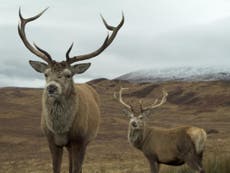Boom in wild deer numbers poses major threat to woodland as demand for venison collapses due to pandemic
Lack of predators means annual culls remain vital to maintain biodiversity, but with restaurants closed, venison prices have fallen sharply

Your support helps us to tell the story
From reproductive rights to climate change to Big Tech, The Independent is on the ground when the story is developing. Whether it's investigating the financials of Elon Musk's pro-Trump PAC or producing our latest documentary, 'The A Word', which shines a light on the American women fighting for reproductive rights, we know how important it is to parse out the facts from the messaging.
At such a critical moment in US history, we need reporters on the ground. Your donation allows us to keep sending journalists to speak to both sides of the story.
The Independent is trusted by Americans across the entire political spectrum. And unlike many other quality news outlets, we choose not to lock Americans out of our reporting and analysis with paywalls. We believe quality journalism should be available to everyone, paid for by those who can afford it.
Your support makes all the difference.Wild deer numbers are on course to surge, with grave impacts on woodlands, after demand for venison collapsed with the closure of the hospitality industry during the coronavirus pandemic.
While sales in supermarkets and butchers have remained “strong” throughout the crisis, according to industry organisation Scottish Venison, demand has fallen by “as much as 60 per cent" as restaurants, caterers and the wider hospitality sector have been operating at a fraction of their pre-pandemic scale.
Unchecked deer populations are a major concern for conservationists because grazing means trees and shrubs are unable to regenerate, hampering efforts to tackle the climate and biodiversity crises through increased tree cover.
Historically, predators such as wolves and lynx preyed on deer, keeping their numbers in check, but the extinction of wolves in the UK in the late 17th century and of lynx in the medieval period means deer populations are only kept in check by culls.
Last year a report estimated up to one million wild deer could be roaming Scotland, almost double previous estimates, representing a major threat to already largely overgrazed landscapes which were once covered with forest.
According to the Scottish government, since 1959 there have been “substantial increases in the distributions and numbers of Scotland’s four species of wild deer”. The number of deer shot in Scotland has also increased considerably over that time, indicating existing culls are not keeping deer numbers in check.
More than 100,000 deer are culled each year, it is thought culling fell by 80 per cent last year, game chef Mike Robinson told The Guardian.
Dick Playfair of Scottish Venison told The Independent: “In Scotland we have been doing what we can to keep supply chains moving and encourage alternative routes to market.
“There has been some shift towards local sales through butchers, mail order and click and collect but this doesn’t compensate for the massive loss of demand through the restaurant, catering and hospitality sector.”
Brexit has also impacted venison markets.
Mr Playfair said: “Exports are also more difficult. There were some issues towards the end of the transition period and there are still aspects to resolve to ensure smoother access to European markets going forward.”
This lack of a route to market has left prices for venison in freefall, reducing the profitability of sales.
Mr Playfair said: “Prices paid to estates for venison have dropped from £2.20/kg last year to around £1.00/kg or less this season so estate/stalking businesses are taking a hit on venison sales as well as a significant loss on stalking income.”
Martin Fowlie, a spokesperson for the RSPB, told The Independent: “Deer are an integral part of our ecosystem but without natural predators here in the UK, deer populations need to be maintained at sustainable levels. And this maintenance needs to be done by people.
“Too high a density of deer does damage, and strips away the variety within habitats to create uniformity that is less good for other wildlife. This can spell trouble for some species such as the already struggling nightingale.”
The Scottish government has put up funds to help the sector market venison in Britain.
Mr Playfair said: “The Scottish government has made a £50,000 grant available to the Scottish venison sector to support marketing in the UK. This campaign was planned for December but with the Christmas lockdown of restaurants, it will now launch in March.
“Encouraging more people to eat more venison is vital, to buy venison wherever they can, its health benefits are unequalled by any other red meat, and eating venison has significant upstream benefits for our ecosystem.”




Join our commenting forum
Join thought-provoking conversations, follow other Independent readers and see their replies
Comments